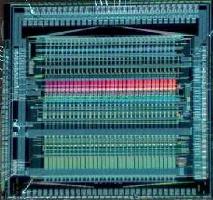"PRO/A chip evaluation."
|
Together with our Norwegian colleagues we assembled an
experimental setup and worked out a method for the ASIC
tests. An independent series of calibration measurements
was held for a few ASICs at DESY Zeuthen in the low-noise
laboratory conditions. Then the whole data set from Oslo
was renormalized. The IDE AS company sent us 203 tested
ICs, but only 48 of them plus some spares had been chosen
for the Pad detector. The yield of 25% made us possible
to apply a rigorous cut.
Bias voltages could be measured to a high precision.
The data obtained had a regular structure correlated to the
wafer's number and the chip position on it. The maximum
deviation observed was in order of 10% indicating
technological deficiencies.
A signal-to-noise ratio (SNR) for every individual
channel was chosen to define the ASIC's quality. The rejection
power of the SNR-cut has a critical value and above it the number
of accepted ICs decreases very rapidly. Therefore this method is
good to reveal all those deffective devices with a high noise and
(or) a small gain. The chip was refused, if at least one of its
channels did not fulfill the SNR-criterion. An additional cut was
applied accordingly to the best choice of the operating threshold
voltage. The worst channel with the smallest gain and the largest
noise thus, determines the common threshold for the whole chip.
As higher the threshold to discriminate the same input signal, as
more the detector is safe against the noise triggering. The
positive outcome was nearly 83% (31% - perfect and 52% - good).
About 4% did not pass the quality check and the remaining 13%
had no reasonable data.
There were two different computer systems used for
the data acquisition: "Windows 98" in Oslo and "MacOS 8.0"
at DESY Zeuthen. For both platforms, the "Microsoft Excel"
framework provided a compatible data format. By this
reason the evaluation chain was written in the "Visual
Basic" programming language.
